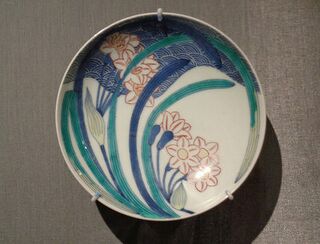Difference between revisions of "Nabeshima wares"
(Created page with "right|thumb|320px|A Nabeshima ware piece from c. 1700-1750. (LACMA M.2007.8) *''Japanese'': 鍋島焼 ''(Nabeshima yaki)'' First produced in [[162...") |
|||
| Line 3: | Line 3: | ||
First produced in [[1625]], Nabeshima wares are a style of [[porcelain]] [[ceramics]] produced exclusively at kilns in [[Saga han]] controlled by the [[Nabeshima clan]] lords of that domain. During the [[Edo period]], Nabeshima wares were not entered onto the market, but were exclusively produced for the use of the Nabeshima ''daimyô'', and for the Nabeshima to present as gifts to other lords, or to the [[shogun]]. | First produced in [[1625]], Nabeshima wares are a style of [[porcelain]] [[ceramics]] produced exclusively at kilns in [[Saga han]] controlled by the [[Nabeshima clan]] lords of that domain. During the [[Edo period]], Nabeshima wares were not entered onto the market, but were exclusively produced for the use of the Nabeshima ''daimyô'', and for the Nabeshima to present as gifts to other lords, or to the [[shogun]]. | ||
| + | |||
| + | Distinctive versions unique to Nabeshima wares of the overglaze enamel techniques introduced to Japan from China in the 1640s were passed down among Nabeshima wares artists as carefully guarded secrets. Efforts to maintain this secrecy extended to forbidding most potters in the area of the kilns at Ôkawachi (today, Imari City) from traveling; some scholars have described them as "virtual prisoners."<ref>Nicole Coolidge Rousmaniere, ''Crafting Beauty in Modern Japan'', University of Washington Press (2007), 16-17.</ref> | ||
Only a very few copies of a given design (usually no more than ten) were produced, and secrets of the techniques were kept closely guarded. | Only a very few copies of a given design (usually no more than ten) were produced, and secrets of the techniques were kept closely guarded. | ||
| Line 10: | Line 12: | ||
==References== | ==References== | ||
*Gallery labels, "Dish with Daffodil and Wave Design" (M.2007.8), LACMA, 17 Jan 2015. | *Gallery labels, "Dish with Daffodil and Wave Design" (M.2007.8), LACMA, 17 Jan 2015. | ||
| + | <references/> | ||
[[Category:Art and Architecture]] | [[Category:Art and Architecture]] | ||
[[Category:Edo Period]] | [[Category:Edo Period]] | ||
Latest revision as of 01:50, 5 August 2020
- Japanese: 鍋島焼 (Nabeshima yaki)
First produced in 1625, Nabeshima wares are a style of porcelain ceramics produced exclusively at kilns in Saga han controlled by the Nabeshima clan lords of that domain. During the Edo period, Nabeshima wares were not entered onto the market, but were exclusively produced for the use of the Nabeshima daimyô, and for the Nabeshima to present as gifts to other lords, or to the shogun.
Distinctive versions unique to Nabeshima wares of the overglaze enamel techniques introduced to Japan from China in the 1640s were passed down among Nabeshima wares artists as carefully guarded secrets. Efforts to maintain this secrecy extended to forbidding most potters in the area of the kilns at Ôkawachi (today, Imari City) from traveling; some scholars have described them as "virtual prisoners."[1]
Only a very few copies of a given design (usually no more than ten) were produced, and secrets of the techniques were kept closely guarded.
References
- Gallery labels, "Dish with Daffodil and Wave Design" (M.2007.8), LACMA, 17 Jan 2015.
- ↑ Nicole Coolidge Rousmaniere, Crafting Beauty in Modern Japan, University of Washington Press (2007), 16-17.
